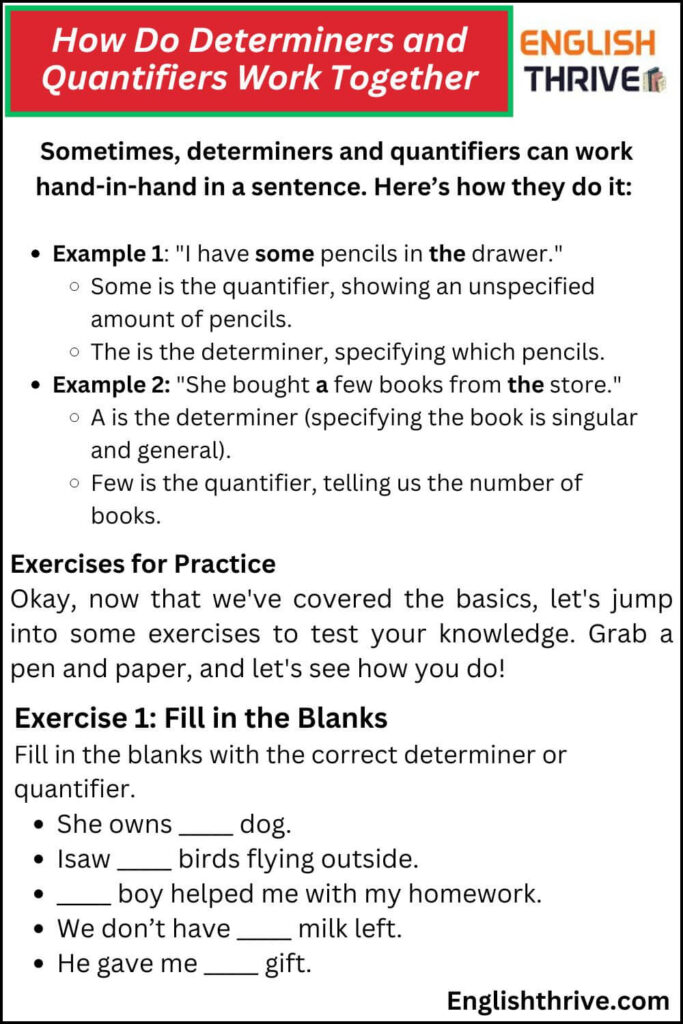Have you ever been unsure whether to say “a few friends” or “some friends”? Don’t worry — this is a common problem for English learners! Knowing when to use the right word before a noun can be confusing, especially when it comes to determiners and quantifiers.
These small but powerful words help make your sentences clear and meaningful. They show how many, how much, or which one you’re talking about — and using them correctly can make your English sound more natural and confident.
In this guide, we’ll break down determiners and quantifiers in simple language, with easy examples to help you understand and use them correctly in everyday English. Whether you’re a beginner or just want to improve your grammar, this post will make everything clear.
Let’s get started and make learning determiners and quantifiers simple and fun!
Contents
ToggleWhat Are Determiners?
Let’s start with determiners. In simple terms, a determiner is a word that comes before a noun to give more detail about it. You can think of them as the “helpers” of the sentence. They clarify things like who owns the noun, how many of them there are, or whether we’re talking about something specific or general.
Types of Determiners
Here are the most common types of determiners:
- Articles:
- A (used before singular, non-specific nouns): “I saw a dog.”
- An (used before words that begin with a vowel sound): “She ate an apple.”
- The (used before specific nouns): “I met the teacher yesterday.”
- Demonstratives:
- Words like this, that, these, and those.
Example: “I love this book.”
- Words like this, that, these, and those.
- Possessives:
- Words that show ownership, like my, your, his, her, etc.
Example: “Where is my pen?”
- Words that show ownership, like my, your, his, her, etc.
- Quantifiers:
- These include words like some, any, few, many, several. They provide information about the quantity or amount of the noun.
Example: “She has many ideas.”
- These include words like some, any, few, many, several. They provide information about the quantity or amount of the noun.
- Distributives:
- Words like each, every, either, and neither that refer to individual members of a group.
Example: “He talks to each student.”
- Words like each, every, either, and neither that refer to individual members of a group.
What Are Quantifiers?
Now, let’s talk about quantifiers. If determiners are the helpers, quantifiers are the detailers of quantity. They specify how much or how many of a noun there is. Think of quantifiers as your go-to words for talking about amounts or numbers.
Types of Quantifiers
- Definite Quantifiers
These words are used when you’re talking about an exact amount.
Examples: all, both, each, every.
Example: “He ate all the cake.” - Indefinite Quantifiers
These are used when the exact amount is not clear.
Examples: some, any, many, few, a little.
Example: “I have some apples.” - Distributive Quantifiers
Words like each, every that talk about every member of a group individually.
Example: “Each person got a gift.”
How Do Determiners and Quantifiers Work Together?
Sometimes, determiners and quantifiers can work hand-in-hand in a sentence. Here’s how they do it:
- Example 1: “I have some pencils in the drawer.”
- Some is the quantifier, showing an unspecified amount of pencils.
- The is the determiner, specifying which pencils.
- Example 2: “She bought a few books from the store.”
- A is the determiner (specifying the book is singular and general).
- Few is the quantifier, telling us the number of books.
Exercises for Practice
Okay, now that we’ve covered the basics, let’s jump into some exercises to test your knowledge. Grab a pen and paper, and let’s see how you do!
Exercise 1: Fill in the Blanks
Fill in the blanks with the correct determiner or quantifier.
- She owns _____ dog. (Answer: a)
- I saw _____ birds flying outside. (Answer: some)
- _____ boy helped me with my homework. (Answer: The)
- We don’t have _____ milk left. (Answer: much)
- He gave me _____ gift. (Answer: a)
Exercise 2: Identify the Determiner/Quantifier
Identify the determiners and quantifiers in the following sentences.
- “I read the book you recommended.”
(Determiner: the) - “We need some more time to finish.”
(Quantifier: some) - “She gave me two gifts for my birthday.”
(Quantifier: two)
Exercise 3: Sentence Correction
Correct the mistakes in these sentences.
- “She has much friends.”
(Corrected: “She has many friends.”) - “I have a little books in my bag.”
(Corrected: “I have a few books in my bag.”)
Common Mistakes to Avoid
- “Much” with countable nouns: We say many for countable nouns, not much.
Example: “I have many books” (not “much books”). - “Few” vs. “Little”: “Few” is for countable nouns, and “little” is for uncountable nouns.
Example: “I have few friends” (countable), but “I have little time” (uncountable). - Overusing “the”: Sometimes, we use “the” when we don’t need to.
Example: “I want to visit the Europe” should be “I want to visit Europe.”
Conclusion
Determiners and quantifiers are small but mighty parts of grammar that can really change the meaning of a sentence. By understanding how they work and practicing their usage, you’ll write with more clarity and confidence. It might seem confusing at first, but trust me, once you get the hang of it, they’re easy to master.
So, next time you’re writing, remember to pause and think about what you’re describing. Is it specific or general? How much or how many? Armed with your newfound knowledge of determiners and quantifiers, you’ll be able to write smoother, clearer sentences.


